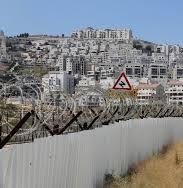Olmert To Approve New Construction in West Bank Settlements
Jerusalem - Prime Minister Ehud Olmert will approve in the next number of days the construction of 800 new housing units in the Orthodox Jewish community of Beitar Illit, located in the Etzion Bloc to the south of Jerusalem, built on hills that Israel acquired after the 1967 war.
Mr. Olmert apprised the Shas Orthodox spiritual leader Rabbi Ovadia Yosef of his decision in a telephone conversation the two men held on Monday.
Shas holds 12 of the 68 seats in Mr. Olmert's shaky coalition. An Israeli prime minister needs 61 seats to maintain a government, since the Knesset comprises 120 members.
Though Prime Minister Olmert has promised not to allow new construction in Judea and Samaria, he changed his mind this week in the face of strong pressure from the Shas and United Torah Judaism (UTJ) parties. Opposition party UTJ goaded its fellow hareidi party, coalition member Shas, to use its leverage to demand a solution to the housing crisis in Beitar Illit.
U.S. Secretary of State Condoleeza Rice, who was apprised of the development by journalists in Amman, Jordan, did not try to conceal her displeasure with Mr. Olmert's steps that did not help the peace process, as she said.
The Jerusalem municipality's District Committee for Planning and Construction on Monday approved the construction of 600 new housing units in Pisgat Zeev in northern Jerusalem. Relations between the Jerusalem municipality and the government became tense some two months ago following reports about delays in the development of Jerusalem neighborhoods that lie on the far side of the Green Line.
Jerusalem Mayor Uri Lupoliansky issued a statement that was fiercely critical of Mr. Olmert. On Monday, he said that he believed that "in the wake of the prime minister's statement that construction in the neighborhoods of Jerusalem would continue, the government will not impose any delays on this plan."
The backdrop to the decision to launch the construction project is the severe lack of new apartments in Jerusalem.
That is why, in the past two years, a number of high-rise projects were approved for central Jerusalem, and the last remaining unbuilt land reserves in the city were rezoned so as to allow for construction. New possibilities for expansion were also examined.
Pisgat Zeev, an area also taken over by Israel during the 1967 war, is the largest residential neighborhood in Israel. It is home to 50,000 people. It was established in the 1990s and is named after the legendary Zionist nationalist leader, Zeev Jabotinsky.
All this means that Prime Minister Ehud Olmert backtracked on Monday on his decision to stop development and construction in the neighborhoods in areas of Jerusalem that were annexed by Israel in 1967.
"I don't need to announce every two days that neighborhoods in Jerusalem will continue to be built," said Mr. Olmert at a meeting of Kadima Knesset members on Monday.
"All of the reports about dramatic construction operations in the territories are incorrect and it isn't true that we're building in violation of the commitments that were given. We aren't building new settlements and we aren't expropriating land for new settlements. Beitar Illit isn't a new settlement, for example. Everyone needs to understand that, and those things were never hidden. With them in the framework, we are conducting the negotiations that are going to continue to advance," Mr. Olmert told the Kadima faction members.

Secretary of State Rice and Prime Minister Olmert are both committed to the two-state solution, only disagreeing slightly on its details. Olmert maintains that existing settlements may be expanded while Rice maintains that they may not. All agree that the existing large settlements like Beitar Illit and Pisgat Zeev will be on the Israeli side of the border in any final status agreement. Other two-state activists say that the State of Israel should return to its 1967 borders and evacuate all settlements in the territories, regardless of their size or when they were built.
The Torah, however, does not distinguish between land stolen in 1967 and land stolen in 1948. We must remember that in spite of all the Zionists' efforts to buy up land prior to the establishment of their state, when the conquest of the land began in 1947, less than 7% of the land belonged to Jews. The rest was either Arab-owned or public land. With the founding of the state, the new Israeli government transferred to the Jewish National Fund millions of dunams of land expropriated from Arabs - the refugees who were not allowed to return ("absentees" in legal language), those who had remained in the country but were absent on a given day from their villages ("present absentees"), as well as Arabs who became citizens of Israel.
It is time for Orthodox Jews to realize that their choices of where to live are, like it or not, an ideological statement of their view on Zionism. Certainly, religious families that move into Beitar Illit, Modiin Illit, Gilo, Pisgat Zeev, Har Homa, Neve Yaakov and parts of Ramot, even if they claim to be against Zionism, are stating with their actions that they support the Zionist claim on this land, which is contrary to the Torah. But this is true even of areas within the Zionist State's 1948 borders, unless one can determine that the land was purchased legally and fairly.